Frida Kahlo and Diego Rivera's iconic life and work showcased at Oklahoma art museum
- Oops!Something went wrong.Please try again later.
- Oops!Something went wrong.Please try again later.
Long before Brangelina or Bennifer grabbed the headlines, Frida Kahlo and Diego Rivera became the celebrity combination that captured the world's attention.
With their iconic artwork, radical politics and tumultuous marriage, divorce and remarriage, the Mexican couple certainly knew how to get people talking.
"That's a huge part of how they became successful was because they made themselves celebrities," said Rachel Keith, deputy director at Tulsa's Philbrook Museum of Art.
"They were incredibly smart, but it's also interesting, because this is, in so many ways, a really nascent moment for the modern press, for newspaper coverage. ... The speed for news to have been traveling, that was still a relatively new thing in the 1940s and in the '50s. So, they certainly were exploring this new medium in many ways and figuring out how to make the most of it."
Through Sept. 11, the Philbrook is exploring the many facets of one of the art world’s most famous power couples with "Frida Kahlo, Diego Rivera, and Mexican Modernism."
"It's been a pretty overwhelming response, I would say. We've had terrific visitation, lots of hours are selling out. ... We hope that everyone will have a chance to come see the show before it closes because it is such a unique opportunity. The same exhibition won't exist anywhere else: They may have even seen some of these artworks before, but the way that we have put everything together here is really special," Keith said.
"So many of the paintings in this show are really the most iconic works by these two incredibly important artists."
Primarily drawn from the collection of Jacques and Natasha Gelman — philanthropists who acquired works from the artists themselves — the sprawling exhibition lets visitors connect to the late, legendary artists through original paintings, drawings, prints, clothing, flowers and more than 100 photographs.
“One of the things I love most about museums is their capacity to bring communities together,” said Philbrook President and CEO Scott Stulen in an email. “This special exhibition gives us the potential to do just that and take a it to a new level.”
Here are eight highlights that make the exhibit a must-see before it closes next month:
1. Frida's self-portraits
Billed as the first Tulsa presentation of paintings by Kahlo, Rivera and many of their contemporaries, the exhibit includes seven of Kahlo’s self-portraits, including her famed 1943 painting "Diego on my Mind," her striking "Self-Portrait with Monkeys" and her dramatic "Self-Portrait with Braid."
Of the 143 paintings Kahlo (1907-1954) created across her career, 55 are self-portraits.
"People even asked her at the time why she made so many (self) portraits, and supposedly — this is anecdotal — she was like, 'I paint what I know best. And I know myself best,'" Keith said.
"So much of her work really was autobiographical, and she saw her work as very personal. ... She was very much interested in sharing her own experience as an example of a Mexican woman."
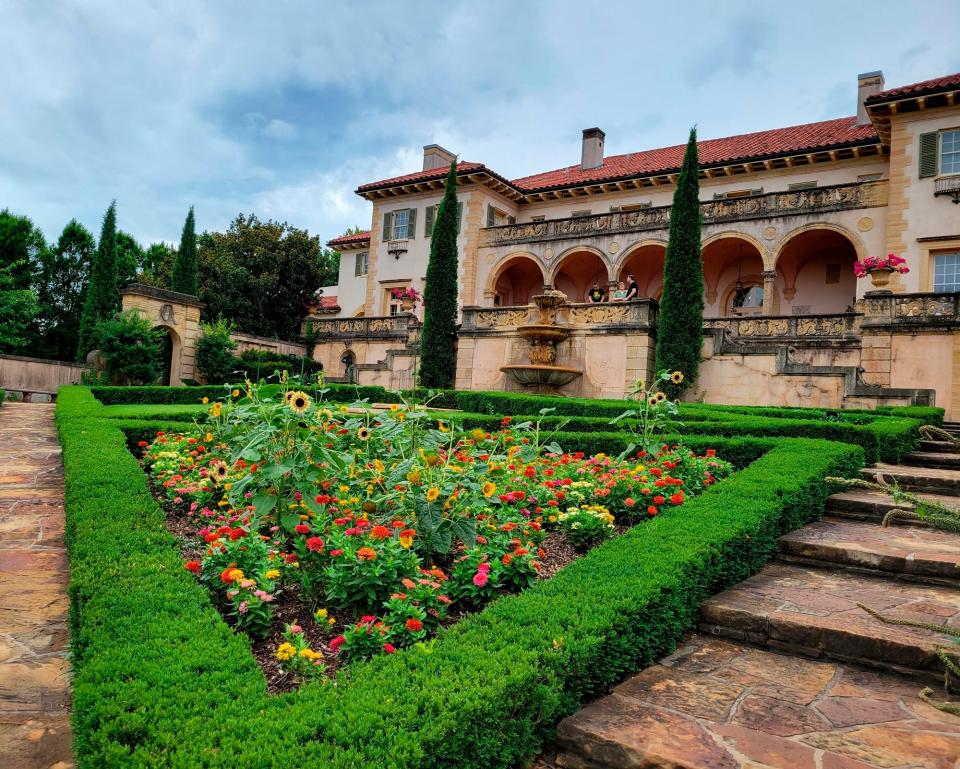
2. Mexican flowers
The Philbrook's vast gardens have been planted with a distinctive Mexican flair in honor of the exhibit.
"We didn't want to present just the same version of this exhibition that's been touring for a long time. It's an interesting mix of artworks, but we also knew that we wanted to work with our gardens because they're such an amazing resource. And gardens were so important to both Kahlo and Rivera," Keith said.
"For her, art and life and her garden or nature, they were all part of one whole. There was no distinguishing between these in her mind. And what we saw with Rivera was very much the same. ... He was also really passionate about gardening; he included plants and flowers in most of his artwork."
From zinnias and sunflowers to bougainvillea and prickly pear, the Philbrook Gardens feature many of the plants the pair might have grown. There's even a recreation of the courtyard of La Casa Azul (or "The Blue House") — the couple's famous Mexico City home, which is now a museum devoted to Kahlo's life and work — worth seeking out in the gardens.
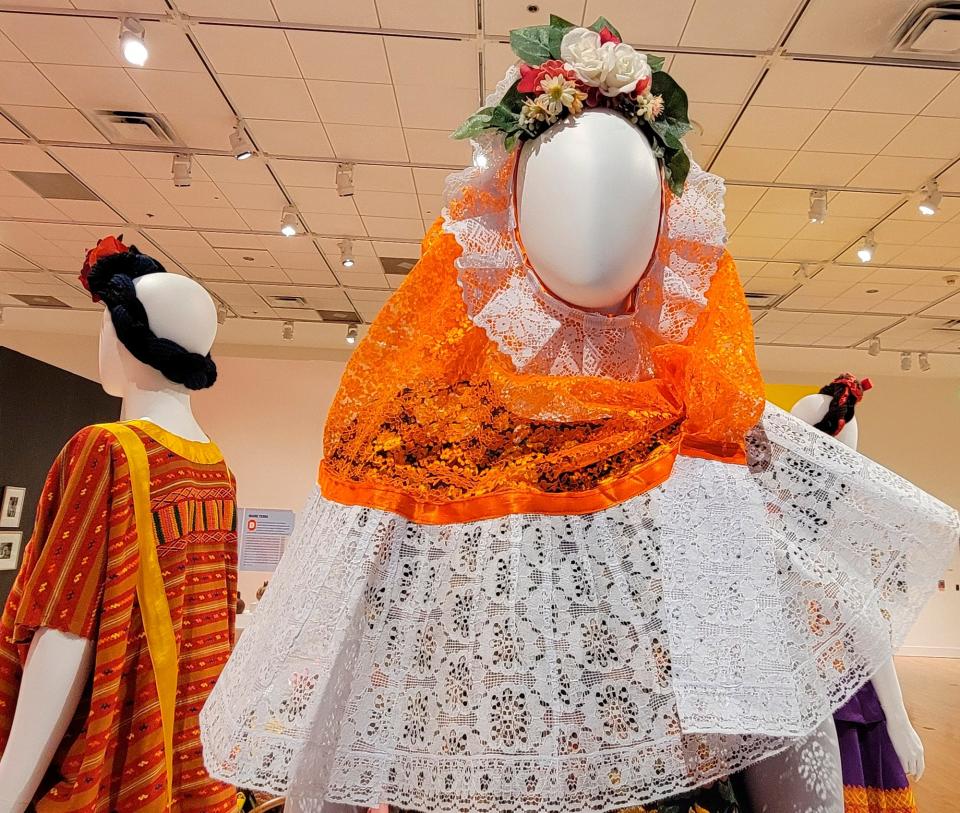
3. Frida's dresses
Since Frida was well-known for her sense of style — especially her fondness for wearing the "classic Mexican dress" with flowers in her hair — the exhibition features several mannequins dressed in colorful outfits including long skirts, embroidered huipiles, or square-cut tops, and fringed shawls known as rebozos.
The clothes belong to the Vergel Foundation, one of the exhibit's organizers, which bought them from many of Kahlo's friends.
"Kahlo wasn't the only woman in Mexico, obviously, who was wearing these clothes and intending them very much to be a political statement. ... Many of the women who were associated with Mexican Modernism were also wearing this traditional dress," Keith said.
"She was very much claiming that heritage as her own, so it's really interesting how she used clothing and dress to create the persona that we all are so familiar with today."
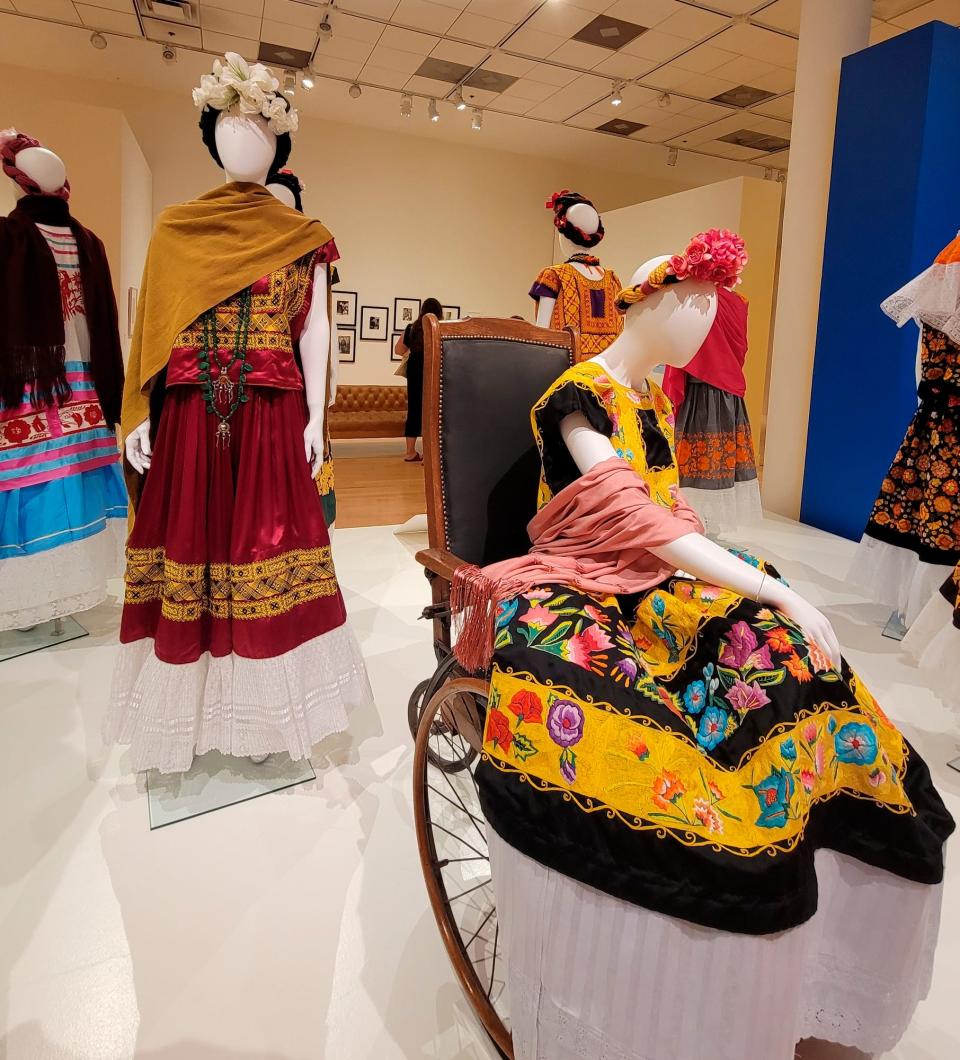
4. Frida's pain
Some of the mannequins are deliberately seated in old-fashioned wheelchairs: When she was 6, Kahlo was diagnosed with polio, which left her right leg shorter and thinner than her left.
When she was 18, she was badly injured when the wooden bus she was riding collided with a metal streetcar. She suffered near fatal injuries from an iron handrail impaling her through her pelvis, fracturing the bone. She also broke her legs, several ribs and her collarbone, and displaced three vertebrae.
"She was dealing with significant physical challenges and was very much a survivor," Keith said. "Supposedly, one of many reasons that led to her unique style of dress and wearing traditional clothing was that the very long skirts would help hide her leg brace ... or whatever kind of apparatus she was using."
Kahlo endured more than 30 operations and a lifetime of lingering pain and complications. In 1953, her right leg was amputated; she died the following year, at age 47.
The exhibit not only includes stark black-and-white photos of corsets, crutches and other apparatus she used to counteract her disabilities, but it also features several of Kahlo's works that speak to the pain she experienced. One of the show's most heart-wrenchingly beautiful pieces, the 1932 lithograph "Frida and the Miscarriage (13th proof)," illustrates the emotional toll of her struggles with infertility, which she likely suffered due to her injuries in the bus accident.
"Her artistic practice was very much a means of healing for her, whether it was a distraction or whether it was working through pain," Keith said.
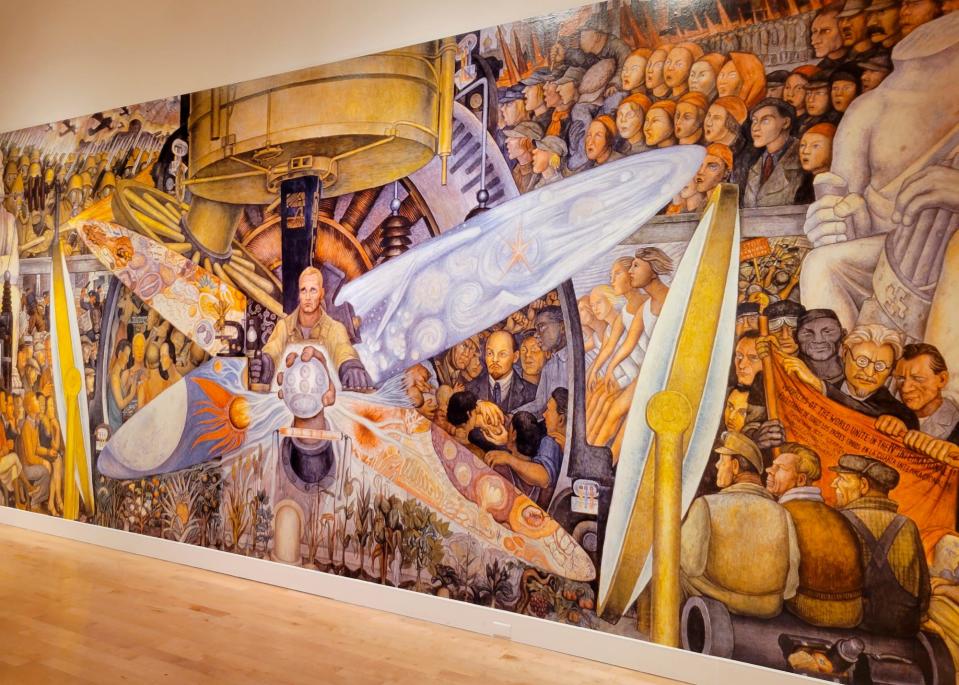
5. Diego's murals
Considered one of the greatest Mexican artists of the 20th century, Rivera (1886-1957) is perhaps best remembered as a leader of the Mexican mural movement, which brought art to the people by creating large-scale paintings to public walls.
To go along with several of Rivera's stunning paintings, the Philbrook staff recreated two of his lush murals on the museum's walls: 1927's "The Blood of the Revolutionary Martyrs Fertilizing the Earth" and 1934's "Man at the Crossroads."
"We were really lucky that a photographer had taken incredibly high-quality images that we were able to license and resize and print locally," Keith said.
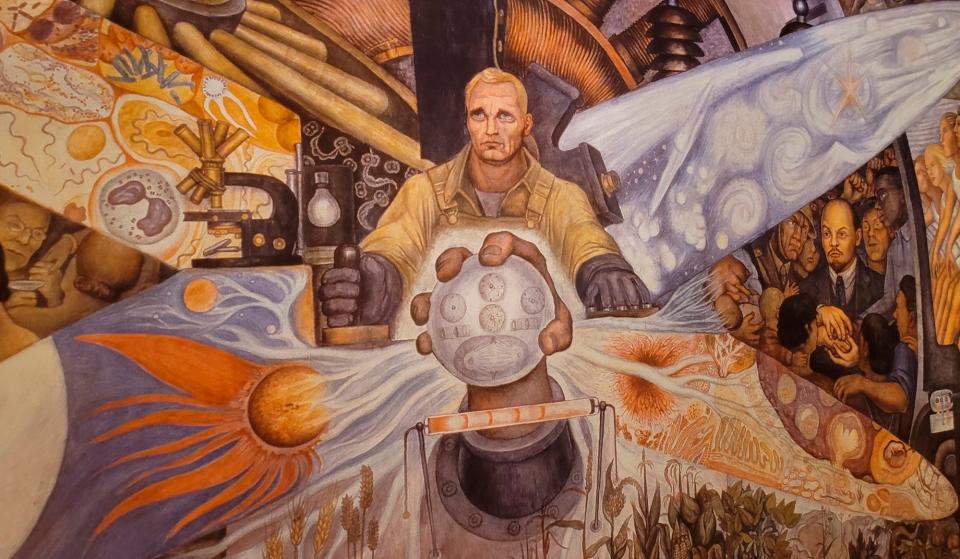
"Man at the Crossroads" has a particularly interesting backstory: The wealthy Rockefeller family tapped Rivera, a member of the Communist party, to paint a large-scale work at the newly constructed Rockefeller Center in New York City. Nelson Rockefeller, uncomfortable with a depiction of Vladimir Lenin in the elaborate mural, asked Rivera to remove that part. The artist refused, so Rockefeller had the mural destroyed. Rivera was reportedly heartbroken, although he was able to create a modified version "Man, Controller of the Universe," for a museum in Mexico City.
"A lot of people think that, for him, it was a media ploy in many ways, that he was aware of how the whole thing would read in the press and use that as an opportunity to strengthen his own image as this very independent political activist, basically, who was not willing to bow to the American financial powers. He couldn't be bought, essentially. But that was all because that fed into the narrative that he wanted people to understand about him," Keith said.
6. Celebrity photographs
From their artwork to their outfits, Frida and Diego were savvy about projecting a particular identity and persona. The celebrity couple was frequently photographed, and Kahlo especially became a coveted sitter of famed photographers.
In 1931, Frida met Hungarian-American photographer Nickolas Muray, a U.S. color photography pioneer. Along with becoming lovers, they collaborated on several vibrant and now-iconic images, and a number of them are on view at the Philbrook.
7. Frida's legacy
Since Kahlo's untimely death in 1954, her legend has grown from acclaimed artist to global icon. Her story has been told in several movies, including the Julie Taymor's 2002 Oscar-winning biopic "Frida," starring Salma Hayek and Alfred Molina, and her distinctive visage appears on items like tote bags, T-shirts and jewelry.
With the section "Beyond Fridamania," the Philbrook exhibit looks at some of the ways that Kahlo continues to impact popular culture and art history, including Yasumasa Morimura's "Dialogue with Myself," in which the Japanese filmmaker transforms himself into and performs as the Mexican painter.
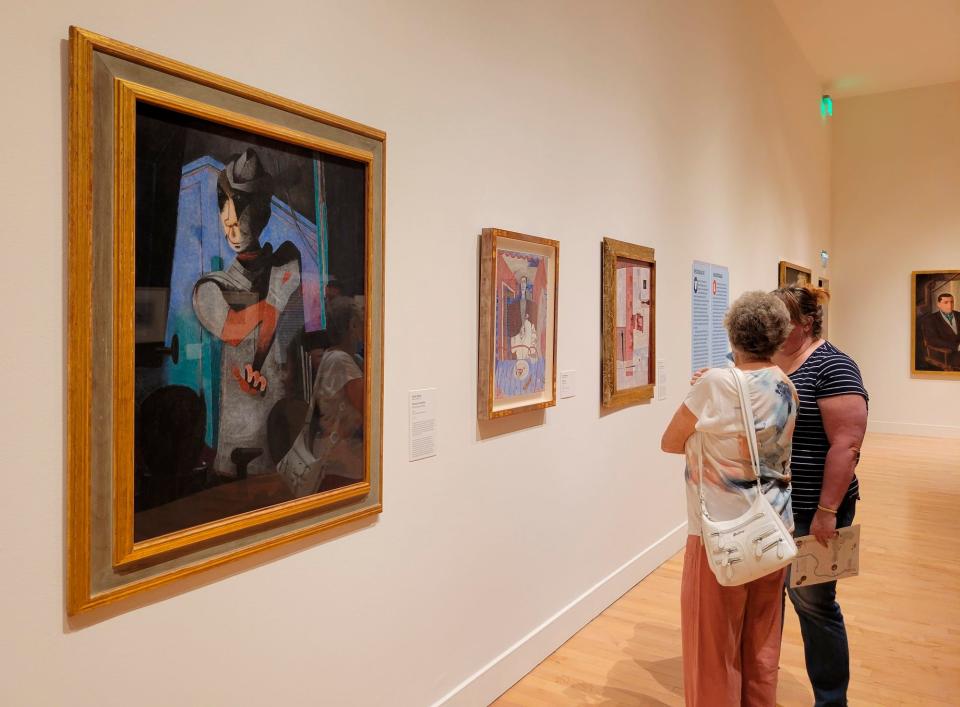
8. Works by other artists
Although they are the most famous, Kahlo and Rivera aren't the only artists from the Mexican Modernism movement featured in the show.
Other highlights include Maria Izquierdo's "Bride from Papantla (Portrait of Rosalba Portes Gil)," Rufino Tamayo's "Portrait of Cantinflas" and Juan Soriano's "Recreation of Archangels." The exhibit even includes a photograph of "Mexico City, Metropolitan Cathedral, Antique Organ and detail of the Choir Stalls" by Guillermo Kahlo, Frida's father.
'Frida Kahlo, Diego Rivera, and Mexican Modernism'
When: Through Sept. 11.
Where: Philbrook Museum of Art, 2727 S Rockford Rd., Tulsa.
Tickets and information: https://philbrook.org.
This article originally appeared on Oklahoman: 8 highlights of Philbrook's Frida Kahlo, Diego Rivera exhibit in Tulsa

